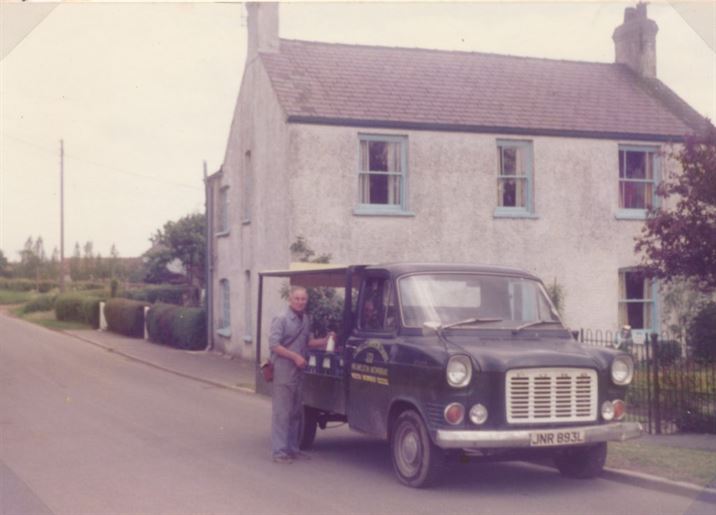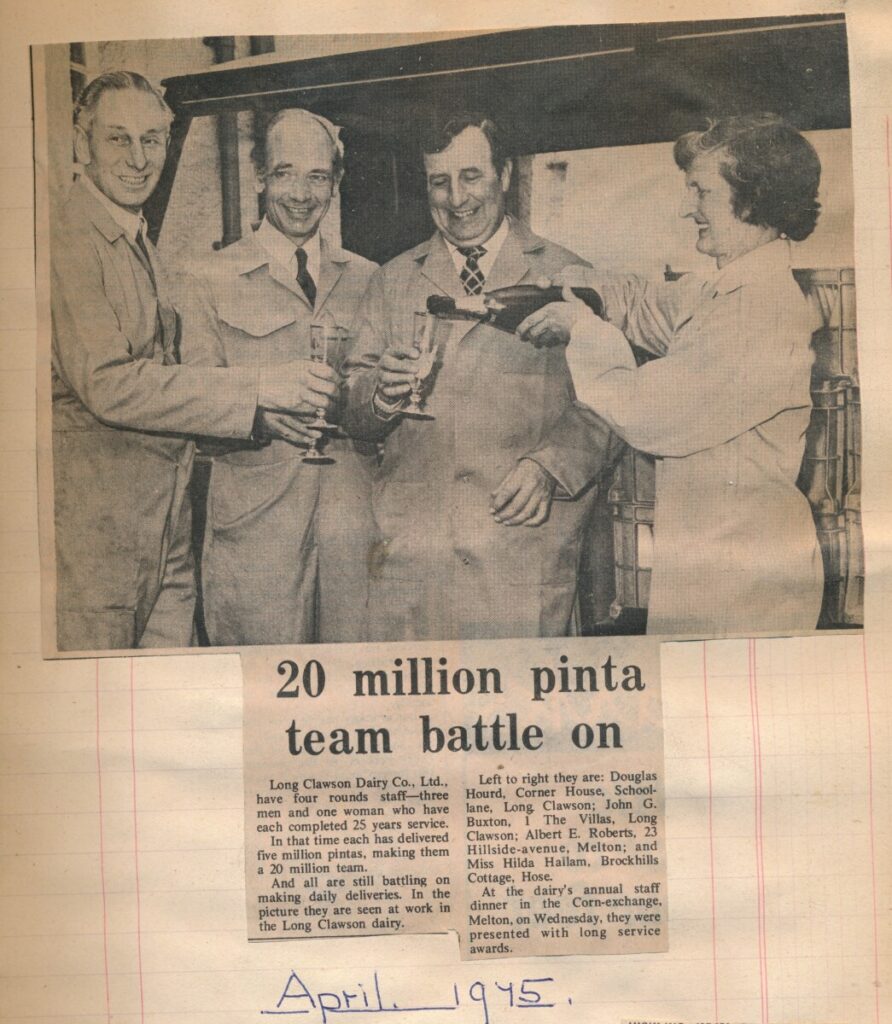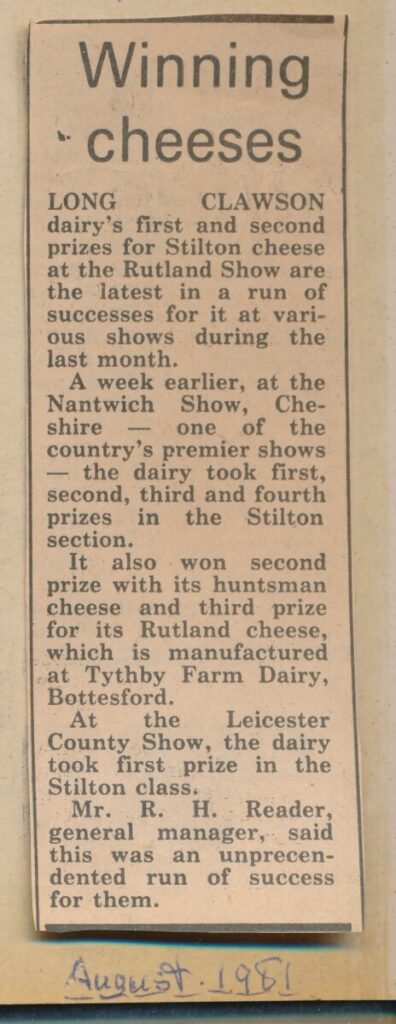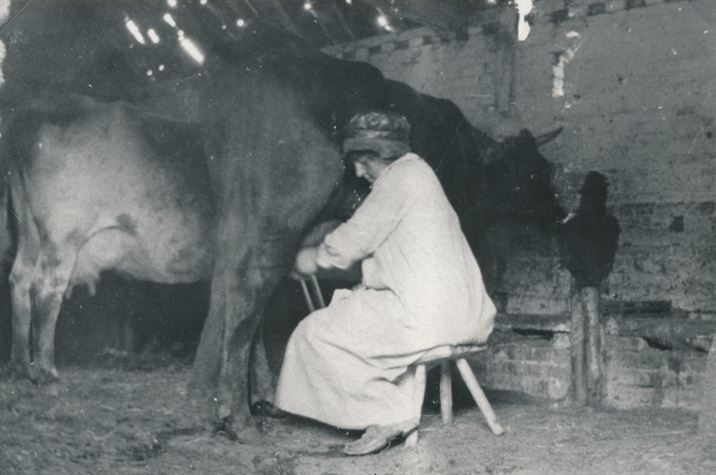The connection between Hickling and Long Clawson Dairy is long-held; stilton-making is recorded as a home industry in the village (see book extracts, below) and, today, the supply of milk from Hickling farms to Long Clawson Dairy is the reason that we still have a thriving farming industry in the village.
A detailed history of these links and our shared history is ongoing; this page will be updated as soon as this work is ready for publication.
From the Wadkin Archives:
In the News:
(see also, general articles for lectures and dairy schools held in the early 1900s)
February 11th 1905: Lecture. – On Friday evening week, a lecture was given in the Hickling Council School, under the auspices of the Education Committee of the County Council, on “Co-operation in Dairy Work,” by Mr JF Blackshaw, FCS, Principal of the Midland Agricultural and Dairy Institute. The Rev HG Laine presided. There was good attendance, including a party from Colston Bassett.
1950: Hickling Diamond Wedding. The Diamond Wedding of Mr & Mrs GA Faulks is reported; Mrs Emily Faulks is reported as ‘one of the last remaining farmers’ wives in the village who made the famous stilton and Colwick cheese.’
April 1974: Hickling Farmer had many Interests. Hickling farmer Mr Frederick Herbert Wiles, a bachelor, has died at Home Farm, where he had lived since he was a child. Aged 64, he was born in the village, one of seven children of the late Mr and Mrs GT Wiles, and carried on farming after his father’s death. Interested in village activities, he had been a parish councillor for many years, a member of the local Conservative Association committee, and, in his younger days, a keen cricketer. The funeral service took place at St. Luke’s church, Hickling, conducted by a former Rector, the Rev L Foster, assisted by the present Rector, and organist was Mr J Munks, cousin of Mr Wiles. Family mourners were Mr & Mrs TGW Wiles, Miss MA Wiles, Mr & Mrs C Tomlinson and Mrs EK Peet, brother, sisters and in-laws; Mr and Mrs J Wiles, Mr and Mrs B Wiles, Mrs R Leavsley, Mrs D Allen, Mr and Mrs R Tomlinson, Mr A Peet, Mr and Mrs D Norton, Mr and Mrs J Peet and Mr G Wiles, nephews and nieces. Mr and Mrs A Hewson, Mr B Doubleday, Mr W Doubleday, Mr and Mrs S Eggleston, Mrs K Doubleday, Mr and Mrs G Doubleday, Mrs G Wiles, Mrs M Munks, Mrs J Munks, cousins; Mrs F Peet and Mrs S Richardson. Among the large congregation were representatives of Long Clawson Dairy, the Quorn Hunt, the parish council, Cricket Club and Conservative Association.
Representatives from Long Clawson Dairy were also present at the funerals of:
- Mr Norman W Marriott, The Yews, Hickling (3rd April 1975)
- Mr John George Parkes, Church Farm (10th April 1979)
- Mr TGW Wiles, Long Clawson (1979); extensive news article headlined, ‘Agriculture’s great loss by death of Long Clawson farmer’ which includes an account of his connections to Hickling, the development of local milk rounds and Stilton Cheesemaking (see scans of full article).
April 1975: 20 million pinta team battle on. Long Clawson Dairy Co., Ltd., have four rounds staff – three men and one woman who have each completed 25 years service. In that time each has delivered five million pintas, making them a 20 million team. And all are still battling on making daily deliveries. In the picture they are seen at work in the Long Clawson dairy. Left to right they are: Douglas Hourd, Corner House, School-lane, Long Clawson; John G Buxton, 1 The Villas, Long Clawson; Albert E Roberts, 23 Hillside-avenue, Melton; and Miss Hilda Hallam, Brockhills Cottage, Hose. At the dairy’s annual staff dinner in the Corn-exchange, Melton, on Wednesday, they were presented with long service awards.
1977: Stilton should be Withcote? The Stilton Cheese Makers’ Association, who explain why Stilton is so called – because it was first sold in the village of that name in Huntingdonshire, but never made there – have been taken to task by Mr Harry Huckerby, of Long Clawson, Nottinghamshire, a retired civil servant who also used to work on his father’s farm. He says the cheese should have been called Withcote Cheese, because it was first made in that village, which is in Leicestershire, bordering on the former County of Rutland. His evidence is over 100 years old, being recorded in an old directory. He holds that the cheese was invented by a Mrs Pick, of Withcote, but the Stilton Association say that a Mrs Paulet, who had a farmhouse near Melton Mowbray, supplied her product to a pub in the village of Stilton – and that is how it got its name.
June 1980: Sir John and Lady Starkey’s Devanna Laddies Prince from their Edingley herd which was Jersey male champion at the Leicestershire Show at Loughborough. Stockman Mike Saxby is holding the bull. In the Stilton cheese class it was a first and second for Long Clawson Dairy Ltd. The first cheese came from their Hose dairy and the second from their Harby establishment. Third cheese in a well-entered class was from Colston Bassett and District Dairy.
April 28th 1981: Vale Still Hit by Blackouts. Electricity men were today working flat out to restore power to thousands of homes in the Vale of Belvoir cut off during the weekend’s blizzards. Some parts there have already had power restored after 36 hours – but others will have to wait until tomorrow. The chairman of the Long Clawson dairy, Mr John Wiles, said the devastation in the vale had to be seen to be believed with power lines and trees down everywhere. Hordes of dairy cows had to be transported by road to other farms for milking; village shops could be facing a massive loss because food in their freezers may go off; an engineering works closed down yesterday; and the picturesque rural vale was again in utter darkness last night with homes having no lighting or heating. And at Redmile, near Bottesford, residents were expecting to be reconnected later today. Mr William Simpson who runs a grocer’s shop in Main Street, said villagers, without electricity since Sunday morning, had been emptying their freezers and giving the contents to friends to stop the food rotting. (…)
August 1981: Winning Cheeses. Long Clawson dairy’s first and second prizes for Stilton cheese at the Rutland Show are the latest in a run of successes for it at various shows during the last month. A week earlier at the Nantwich Show, Cheshire – one of the country’s premier shows – the dairy took first, second, third and fourth prizes in the Stilton section. It also won second prize with its huntsman cheese and third prize for its Rutland cheese, which is manufactured at Tythby Farm Dairy, Bottesford. At the Leicester County Show, the dairy took first prize in the Stilton class. Mr RH Reader, general manager, said this was an unprecedented run of success for them.
January 1982: Film shown at the January WI Meeting. Hickling WI members were entertained with an illustrated talk on the history of Long Clawson Dairy by Mr R Reader and Miss J Morris at their monthly meeting when Mrs J Evans presided.
In the Wadkin Books:
Hickling: Reflections of Yesteryear:
- (p.62) At the mid-day dinner very often the pudding was eaten before the main course. Meat was expensive and it was felt that a good steamed pudding partly satisfied the appetite and therefore not so much meat was needed. Rabbit stew, rabbit pie and pigeon pie was eaten regularly. Farms were completely different from what we know today. The farmer kept just a few cows, the surplus milk sold locally and the rest made into butter and cheese. A number of people kept just one cow, often some distance from the village. The man of the house milked the cow in the field before going to work perhaps cycling or walking some miles. On returning home in the evening he again went and milked, bringing the milk home in a churn held between two large iron wheels which he pushed. Milking of course was all done by hand, milking machines hadn’t arrived. On slightly larger farms where there would be a larger supply of milk the churns were collected daily by either the Nottingham co-operative Society or by Mr. Wilf Woolley of Barland Fields, who took this to Long Clawson dairy. Stilton cheese was made and kept until it was blue. Once a year it was packed in straw and taken to be sold at Melton Cheese Fair. A number of smaller farmers also made Colwick cheese and this was taken to Nottingham along with the new stilton known as ‘green stilton’.
- (p.65) Mrs. Mary Rose known to most children as ‘Granny Rose’. She came to Hickling from Riseholme in Lincolnshire and later married Thomas Clement Rose. Mr. & Mrs. Rose created a reputation for their ability in making stilton cheese and butter.
Maggie’s Memories:
- (p.3) CHRISTMAS at Rose Cottage as I remember when a girl. Uncle Alf and Aunt Lily and Cousin Rowly Pepper always came to stay over Christmas, they lived at Melton Mowbray. For Christmas dinner roast beef was a must. And one of the vegetables, salted kidney beans, home made plum pudding and brandy sauce. Boxing Day dinner was cockerals (which Uncle Alf brought as a present) and all the family came for tea and supper. Tea consisted of tinned fruit, jelly, blancmange and custard, bread and butter, cakes and Christmas cake. For supper home cured ham and home made pork pie, Stilton cheese, mincepies and lemon curd tarts baked in individual patty tins (and these were quite large against todays pastry tins which are in sets of twelve or six) and of course trifle with always tea, and tea only to drink. The best dinner and tea service were brought out and washed so carefully and always used at Christmas. Huge fires would be burning in both front rooms from early morning and always during Boxing Day evening. There would be a family sing-song around either the piano in one room or the American organ in the other and Donny would play either his violin or comet with Emmie or myself on piano or organ. After a good sing-song the older ones would settle down for a game of cards and the younger ones with the usual festivity games.
- (p.7) In the winter when it was too cold for us to play outside, Lucy and I were allowed to go into the warm cheese room at Water Lane, where we could sit and read and write, we also roasted apples on the top of a round black stove which stood in the centre of the room, a lovely sight it would be these days to see the cheese rooms of every farm house filled with dozens of homemade Stilton like when I was a girl.
- (p.9) Methodist Sunday School Anniversary Day at Rose Cottage was an occasion, afternoon service then home for tea where fourteen or more would sit down to tea using Granny Simpson’s best tea service, the hand painted wild roses, then evening service and back home to supper, often bringing one or two other visitors from the surrounding villages for supper, the best dinner service was used, everything was home made and it was tradition to have home cured ham, Stilton cheese and curd cheese cake for supper. The Anniversary always took place on the last Sunday in June (Hickling Feast) they were happy days.
- (p.15) I must mention the supper, a typical country haymaking meal. Home cured ham with plenty of fat running through, a large dish of hot new potatoes, salad, but not like the todays salad, this was a lettuce cut into small shreds, sliced onion, chopped mint, sugar, put altogether in a large vegetable dish until serving time. Tomatoes and cucumber were served on individual dishes, Beetroot was always baked in the oven, never boiled, it was then sliced and covered in vinegar. Stilton cheese and not a skinny half pound as we buy today, but either a whole or half cheese, and sometimes it would pong to high heaven, but my goodness it was good. Also Colwick cheese, plates of bread and I don’t think the bread was spread with butter, just good wholesome fresh bread, then of course curd cheesecakes on plates, fruit pies, lemon curd tarts and jam tarts and plenty of tea. During the latter part of Granny Simpson’s life, she actually relented and allowed the men to have a bottle of beer with their supper if they wished.
- (p.35) Slashing the Ham was another competition. Sometimes either a whole or half Stilton cheese was another prize and every prize given, since these days we have held a number of garden parties in different gardens and fields.
- (p.45) Our village was always noted for its ‘mucky streets’ (and still is) and jolly good stilton cheese which almost every farmers wife made, and the village was full of farmers or smallholders, and each had a cheese room, the women also made butter and Colwick Cheese, every day, seven days a week one would see a line of cheese cloths hanging out to dry (no three day week in those days). The ‘colic’ or ‘Colwick’ or Soft cheese were delicious, would cover a large dinner plate, and compared with todays small white and leathery so called colic cheese, doesn’t seem to be any taste, in fact chives are now added for flavour. Every country kitchen cook made curd cheesecakes, they too would be cooked on large plates, the real, down to earth curd fetched from any farmer who made cheese. I remember taking a large yellow basin and it would be full to the brim with curd, and cost one shilling, the country way of making curd cheesecake is to line plate with short pastry, mix curd with fork, add egg, sugar, butter or marg, and currants mix well together but the mixture should not be too soft, fill pastry with mixture and bake, this was, and still is a favourite with Rowly Pepper and Cecil Rose.
- (p.46) In these times 1920 & 30’s some farmers sold milk at the door (it is not allowed now) housewives would take a jug and measure milk from the chum. There was no delivery of milk until I was grown up, Mr. H. Bames of Kinoulton took chum in car and measured into jugs etc. at the door. Co-op I think were the first to deliver bottled milk they transferred business to Clawson Dairy who now has the monopoly, one can also buy cream and stilton cheese from the milkman.
- (p.88) Mrs. Sarah Louise Cart wife of Mr. F.J. Cart I have mentioned. She was a farmer and a prize winning stilton cheese maker, she won many challenge cups over the years. Her elder sister Miss Emily C. Hives lived with her, she was the drudge and Mrs. Cart the lady, but she did work hard in the cheese room, and at one time she also was a dressmaker.
- (p.89) Mr. Joseph Spencer lived at Bridge Farm, he was a bargeman, and have heard say he would put his wages inside the sole of his sock before walking home on the canal bank. Mrs. Martha Spencer also won prizes for making Stilton Cheese and awarded challenge cups for prize bulls and other beast, one son Robert is living here at the Old School House.
- (p.89) Mr. & Mrs. George Faulks Farmer, lived at Canal Farm before moving to ‘Sycamore Farm’ in the village where they lived until their deaths. Mrs. Faulks, a hard working woman also was a good Stilton Cheese maker, had a large family, one son being killed during the 1914-18 War, there are still three sons and one daughter living, and two grandsons and families live here in Hickling.
- (p.95) Farmers One or two sold milk daily to residents, no delivery. Most farmers wives made Stilton and colic cheese also Butter.











































